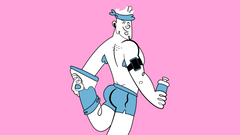You give me cream, I give you cream
Like any self-respecting cosmetics brand, with summer comes our typical article on sunscreens. How to talk to you about “safety recommendations at the exhibition” would have been a stupid jevy… we have decided to dedicate this post to dismantling the most common myths that you can find online 😜

Before you start: the basics of the sun.
The sun is cool, it's cool and it helps your body and mind if you take it for 10-20 minutes, 3 times a week. But if your mother smeared you when you were little so that you slipped on the float, it was for a reason.
Along with all the delicious things it brings, Lorenzo has two types of rays that... I don't like:
-
UVA – A for aging; That is, they make you look older than you are.
-
UVB – B for burn; that is, you burn like a churrero stick
Myth 1: If the cream says SPF, I am protected from the sun
False.
SPF refers to protection against UVB rays, but does NOT refer to UVA rays.
To have UVA protection, you have to look for the words 'broad spectrum protection' on your cream
Myth 2: SPF 15 is for when you want to go tan and SPF 50 if you have very fair skin
False.
The number next to the word SPF indicates... how much 'extra' time it takes for you to burn if you apply cream vs. if you don't put it on. It is a way of measuring protection, INDEPENDENT of the skin type.
With an example it is better understood:
-
If, 'without putting anything on', you last about 5 minutes before burning, with an SPF30 you would last 5x30 = 150 minutes without burning.
-
Yes, 'without putting anything on' you can last 30 minutes before burning, with an SPF30 you would last 30x30 = 900 minutes without burning.

If you are Korean (and, it is understood, aware of skin care and protection 😅), you will put on SPF50 without thinking about your skin tone (not that I know many Koreans with very dark skin, but you understand the idea, right?).
If you are a dermatologist, I definitely recommend that you do not recommend less than SPF30 to EVERYONE, as a rule (never less). If you are someone on the street... well, you change as it works for you.
Myth 3: Natural filters are more environmentally friendly
False.
To protect you from the sun, so-called 'filters' are used, which can be of two types:
-
Physical, organic or 'natural', which are minerals crushed into powder. The effect they cause is that of a barrier or 'wall' that prevents the rays from passing through them. In general, they leave your face white and are doughy. To avoid that 'white face' and paste effect, some brands make 'nano particles' with physical filters... and fish and plankton don't like that at all.
-
Chemical or manufactured in a laboratory. They make a chemical reaction that transforms light into heat. They don't leave your face white and are less sticky... but on the other hand, they tend to irritate sensitive skin more. Of these, there are some such as e.g. oxybenzone or octinoxate, which have been banned in places like Hawaii since 2018.
Conclusion:
-
There are some 'natural' and chemical filters that are bad for the environment.
-
There are other 'natural' and chemical filters that are respectful and good.
Myth 4: If I get 50 protector, I can forget about it and be calm
Half...
Well here, let's add a little drama to the matter, because we like a goodbeef. It turns out that since 2020, some have decided to 'review' the exams that certain brands were removed from 'protection'... and their grades have been lowered. There are many examples of international (and national) creams that had to withdraw their creams from the market because it turned out that they had less protection than what was advertised.
Have we 'sio deceived you'? It is not that either...
In order for a bottle to say SPF 50 or 50+ you have to pay for a study carried out by an independent laboratory (it is not entirely 'credible' that you yourself say that your product is milk). In other words, there are some 'auditors' involved.
If you hire a different 'auditor'... it's like changing the teacher who scores the exam... the score will surely change (up or down).
Did those brands want to deceive you? not necessarily. Now, with the downward revision of some brands, have they put fear into our bodies? Could be...
Thanks to MDMA, today I have a steady job (oh, what a mess...)

The fact is that there is still a LOT of progress to be made in the area of sunscreens and, as with contraceptive methods... here it is not enough to just trust the products that brands make, but you have to put a little bit of coconut and learning into the subject and avoid acting crazy with the sun.
If, as with any poison, you consume 'responsible' and use protection when it comes to it, you will not have a problem and you will be happier than licorice.
Wedge: our Handsomefyer Sun has a broad spectrum SPF50 and combines physical and chemical filters to achieve that protection, but without leaving your face like the gotelé from your grandmother's salon. And we have not included any of the filters that harm the minnows or corals.
We do cool right,
Siwon



